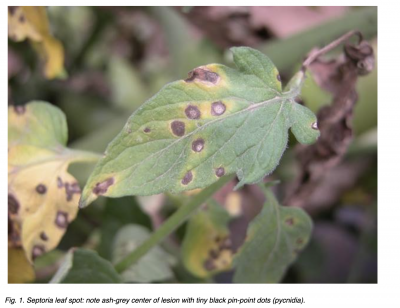Jude Boucher, UConn Extension
Normally, about 30-40% of the tomato plantings in the state have problems with Septoria leaf spot (SLS) in any given year. This past season about 80-90% of the CT farms that I visited experienced damage from this disease.
The fungal pathogen, Septoria lycopersici, overwinters on tomato plant debris or that of another solanaceous weed host, such as horse nettle, nightshade or jimsonweed. SLS can also be spread by infected seed. Infection and growth of the fungus are favored by heat waves, with long stretches of high temperature and humidity, or multiple periods of wet foliage, such as mornings with long dew periods in late August or early September.

The disease first appears on the lower, oldest leaves of the plant as small (1/8”) dark spots with an ash-grey center, and spreads up the plant to younger leaves as the season advances. It can also infect and produce round lesions on the vines. Leaf spots can grow to about 3/8” with ideal conditions and the grey center of the lesion becomes spotted with tiny black dots or pycnidia. The black pycnidia produce additional spores which cause secondary infections on nearby leaf tissue. Spores are spread by splashing rain, equipment, workers or insects, and produce fungal strands that enter leaf stomata (breathing holes). Severely infected leaves wither and die, leaving fruit exposed to direct sunlight and possible to sunscald. Foliage is often reduced to the point where yields suffer or plants are killed. SLS tends to be a little more aggressive and harder to control than early blight.
Management
Hot water seed treatment can eliminate the pathogen on or in infected seed. Dr. Margaret Tuttle-McGrath will be speaking on this subject at the CT Vegetable & Small Fruit Growers’ Conference at Maneeley’s in South Windsor on January 11th.
Crop rotation away from tomatoes for 2-3 years can help prevent the spread of spores from the residue of a previous tomato crop. Shredding and burying the old plant debris after harvest helps decompose SLS spores. Controlling solanaceous weeds, especially perennial weeds like horse nettle, is an important component of effective crop rotation.
Reducing leaf wetness time as much as possible also helps slow disease spread. Trickle irrigation should be used instead of overhead irrigation. Pruning and trellising tomatoes allows plants to dry quicker and reduces the contact between plants and soil debris, and between lower leaves and new growth. Choosing an open site with good air circulation can also help dry foliage quickly.
This summer we witnessed one of the most effective control measures at Oxen Hill Farm in Suffield: caterpillar tunnels. Caterpillar tunnels erected over the field tomatoes stopped heavy dew in late summer, which all but stopped the SLS. Uncovered plants immediately adjacent to the tunnels were killed by the disease (see Fig 2 & 3). This happened with almost no rain in July and August.

Resistant varieties are just beginning to show up on the market. ‘Iron Lady’, a medium-sized slicer has tolerance to early blight, and resistance to late blight and SLS (High Mowing Organic Seeds). ‘Jasper’ is a large cherry tomato with the same combination of “resistance” (Johnny’s Seeds). Cornell and North Carolina State Universities have been cooperating to produce these “triple-resistant” varieties and more will be available in the catalogs soon.
Fungicide applications that protect new growth is usually an important part of managing SLS. Applications usually start soon after fruit begin to form and can be timed using the Tom-Cast blight forecasting model. Initial and follow up applications are based on leaf wetness time and near-optimum temperatures for disease infection and development. Local data is available from farms near you via the Network for Environment and Weather Applications (NEWA) system (www.newa.cornell.edu) which will run the Tom-Cast model for you and tell you when to spray.
Fungicide applications can also be based on weekly field scouting which can pick up problems that the Tom-Cast model cannot, such as bacterial diseases, viruses and insect infestations. The initial application for SLS usually starts when either SLS or early blight are first detected, with followed-up applications on a 7-14 day intervals (average of 10 days), depending upon how wet or dry the weather is. Effective fungicides include: Cabrio, Quadris, Dithane and mancozeb. Copper can provide some protection.